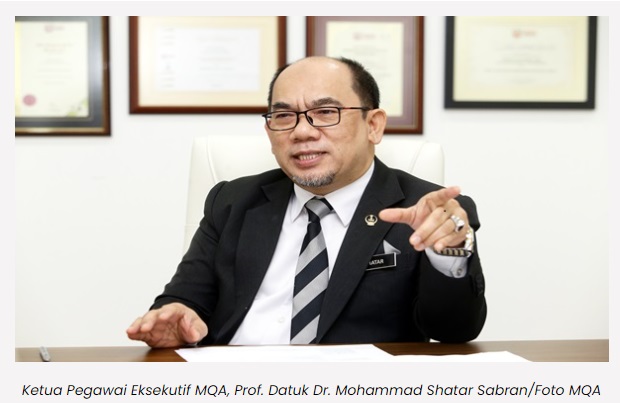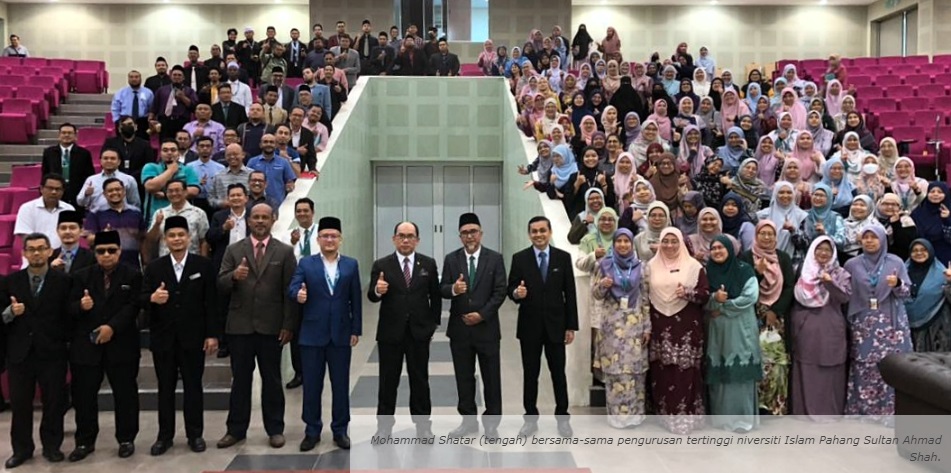|
This section explains in general about the development of Student Learning Hours (JPP) and Self-Instructional Materials (SIM) for UPM ODL programme based on the COPPA:ODL (2019) standard. Compliance with the JPP and SIM guidelines by programme owners is very important in ensuring compliance with the COPPA:ODL (2019) standard.
4.2 SIM DEVELOPMENT GUIDELINE
SIM is a self-study material that aims to enable students to learn on their own (or learn independently) about a topic/issue. The SIM is prepared through a material design and development process.
4.2.1 SIM
- Course developers need to provide a SIM to guide students to achieve the learning outcomes of the course based on the appropriate type of learning material. SIM content features are as shown in Figure 4.2 below
i. Self-learning: A feature that allows students to learn on their own by referring to teaching materials such as notes, activities and assessments provided.
ii. Self-explanatory: A feature that allows students to clearly convey the essence of the topic and the content is presented in a consistent and easy-to-understand
style with minimal additional reference suggestions.
iii. Self-contained: Features are complete and include examples, descriptions, illustrations, hints and references.
iv. Self-motivating:A feature that provides the necessary guidance, pointers and recommendations at every stage of learning. This feature also comes with
learning steps and is student-friendly through a conversational writing style and simple language usage.
v. Self-directed: Features that arouse curiosity and relate the content of the material to the current situation.
vi. Self-evaluating: Features that have self-assessment exercises as activities and assessments for the purpose of measuring student achievement.
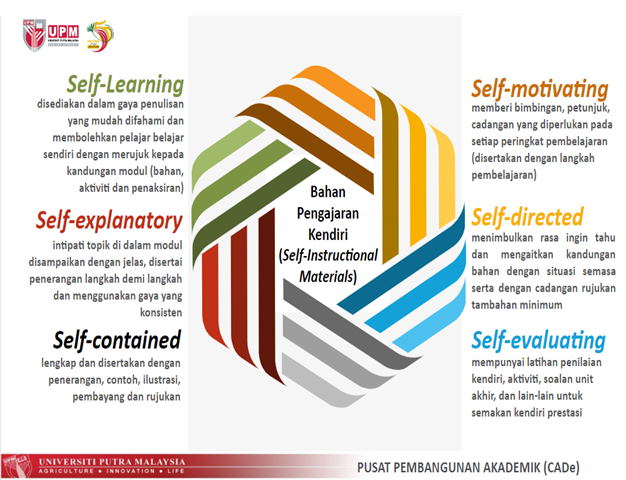
Rajah 4.2 SIM feature
4.2.2 SIM Design
- The SIM design must comply with the SIM features which are self-learning, self-explanatory, self-contained, self-motivating, self-directed and self-evaluating as shown in Figure 4.2 SIM Features and comply with the following five (5) points:
- Have general course information;
- Has an introduction to the course;
- Has course content in the form of self learning modules consisting of learning directions and guides, information on learning outcomes, list of module content, notes in the form of slides/text/images/video/audio, learning activities and assessments, module formulation, reference list and reading materials addition;
- Have a conclusion and conclusion to the course; as well as
- Have a list of references
2. The SIM module design can be planned by identifying the matters shown in Table 4.5 below:
Jadual 4.5 SIM Design Form
| |
Course Name |
Course Code |
Self Check Sim Criteria [/] |
| |
Agriculture and Life |
PRT2009 |
[ ] Self-learning
[ ] Self-explanatory
[ ] Self-motivating
|
[ ] Self-directed
[ ] Self-contained
[ ] Self-evaluating
|
| |
Module 1: |
| |
Learning Outcomes |
Learning Instructions |
Duration |
| |
1. Define the term agriculture.
2. Explain the importance of agriculture.
3. List the types of
agricultural systems.
|
This module explains the concept of modern agriculture.
1. Go through the video to learn how agriculture has transformed throughout the years and share your thoughts in the forum.
2. Answer all the quizzes in three attempts to complete the module.
|
3 hours GD
2 hours SL
|
| |
Content: | Video | Articles | Infographics| Interactive Videos | Slides | Lesson | |
| |
• PRT2009 Topic 1 Introduction and Scope of Modern Agriculture |
| |
• 1 lecture video (11 mins) |
| |
Activities: | Forum| H5P | Games | Glossary | Choice| Workshop| Survey | |
Assessment:| Quiz | Assignment| Graded Forum |
|
Notes: |
| |
Forum discussion on sustainable agriculture video |
Online Quiz (10 questions- multiple choice)
|
Focus on history of agriculture |
| |
Suggested Additional Reading |
References |
| |
1. Why is Agriculture Important and its Role in Everyday Life https://agriculturegoods.com/ why-is-agriculture-important/ |
Behnassi, M., Shahid, S. A., & D’Silva,
J. (2011). Sustainable agricultural development: Recent approaches in resource management and environmentally- balanced production enhancement. Springer Science & Business Media.
|
4.2.3 SIM Development
- SIM is developed in the following way:
a. Adopt existing materials; or
b. Adapting existing materials; or
c. Creating original materials; or
d. Any other appropriate approach.
2. Programme owners should implement attribution practices when re-using open educational resources, as well as consider the protection of intellectual property
rights and the licensing of developed SIMs. Copyright laws and best practices must exist and be followed.
3. The developed SIM should contain complete information and instructions to guide students' self-learning. Various learning items as shown in Figure 4.3 can be
developed using LMS, depending on the learning outcomes and the SIM Development mode should take into account the following:
a. General information about the course should be displayed:
i. course learning outcomes;
ii. lecturer information in the form of introductory videos and pictures;
iii. learning activities such as the number, type of assessment, schedule and assignment delivery method;
iv. communication methods for example through email, Whatsapp group, Facebook group and phone calls;
v. learning schedule and interaction activities; as well as
vi. main reference
b. The selection of the type of material needs to be based on the suitability of the content of the topic to be delivered, namely:
i. slides that contain the content of the topic presented in the form of text, diagrams and videos, as well as accompanied by instructions on how to use the
material for learning purposes;
ii. articles produced in .doc and pdf format, and containing the content of the topic presented in the form of text, diagrams and videos, as well as accompanied
by instructions on how to use the material for learning purposes;
iii. infographics produced to explain the content of the topic summarized in graphic form;
iv. videos explaining topic content, demonstrations, tutorials, talks, field studies and simulations;
v. audio that summarizes the topic content, module learning directions and topic explanation;
vi. links to references on the internet such as YouTube videos, news and tutorials on the internet;
vii. links to Web 2.0 applications for learning purposes (such as Padlet, ThingLink, Mentimeter, Blendspace, Quizizz, Kahoot and Google Drive); as well as
viii. other types of suitable materials
c. The program owner must be responsible for ensuring effective delivery to achieve the learning outcomes of the programme. Activities can be implemented
through two (2) types of learning which are synchronous and asynchronous.
d. The types of activities that can be carried out should be:
i. providing and developing practical skills such as through exercises and reflection to increase understanding of the topic, as well as obtaining information
through additional references via the internet or text;
ii. emphasizing interaction/collaboration between lecturers and students, and fellow students such as through forums;
iii. encourage students to develop their understanding of modules through gamification; as well as
iv. capable of supporting students to check their self-understanding through Feedback functionality that provides automatic responses, or through
communication among students, and/or students-lecturers.
e. A variety of innovative assessment methods and tools must be used appropriately to assess learning outcomes and competencies:
i. assessment to measure student achievement can be implemented such as through assignments and quizzes;
ii. assessment scores can be taken into account to measure student achievement (graded assessment) as an assessment of learning; or not taken into account
for grading purposes (non-graded assessment) as assessment for learning; as well as
iii. assessment can be carried out by automatic review, (through the Quiz function) by the lecturer, or through (the Assignment function).
f. Instructions, information and learning steps must be provided to help students use SIM regularly. The frequency, methods and criteria of student evaluation
including grading criteria and appeal policy must be documented and communicated to students at the start of the programme. Changes to student
assessment methods must be in accordance with the procedures and regulations and be communicated to students before implementation.
g. Appropriate items in the LMS also need to be used and activated with instructions. Lecturers upload materials, track and check the engagement of students
who have completed an assessment and communicate to guide students.
h. The development of SIM needs to be reviewed to ensure that the quality of the material is sufficient and compatible with the mode of delivery. Figure 4.4
can help lecturers ensure the adequacy and need in developing SIM.
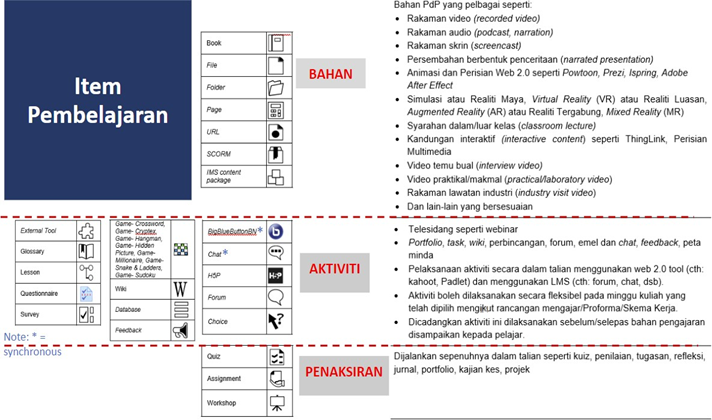
Rajah 4.3 Contoh Item Pembelajaran yang Digunakan Sebagai SIM
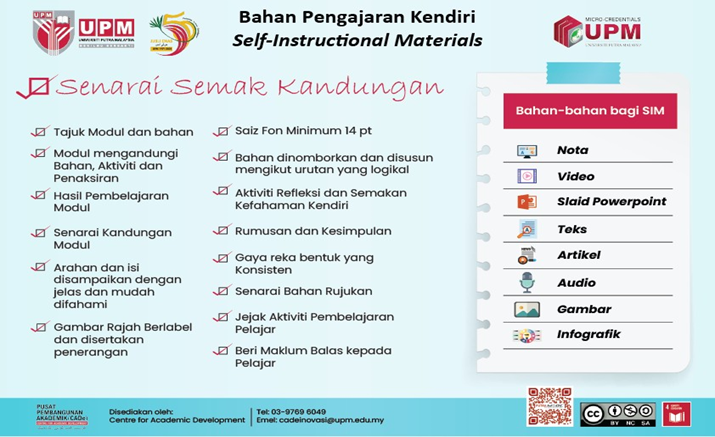
Rajah 4.4 Senarai Semak Pembangunan SIM
Here is a link to an example SIM development design:
a. A module with a self-learning design in the UPM MC course. UPM micro-credentials course development:
https://putramooc.upm.edu.my/
b. SIM in slide/text/article form: http://arcmit01.uncw.edu/hpl0346/ links/food_pyramid_mod.pdf dan https://www.academia.edu/19830142/
MODUL_PENGAJARAN_KENDIRI?email_work_card=view-paper
c. SIM in video form: https://www.youtube.com/watch?v=BBWjl8AmT-s
|


















